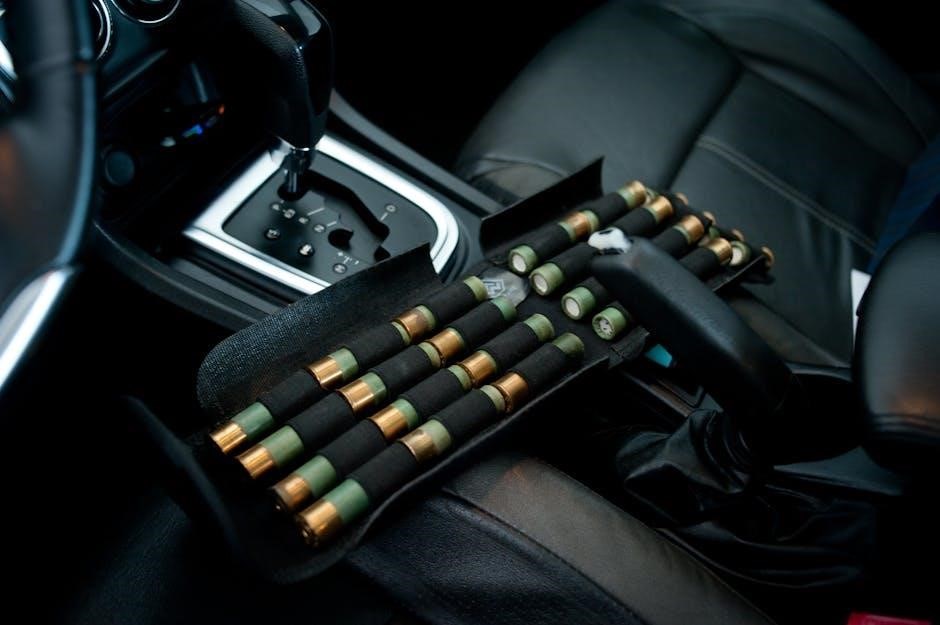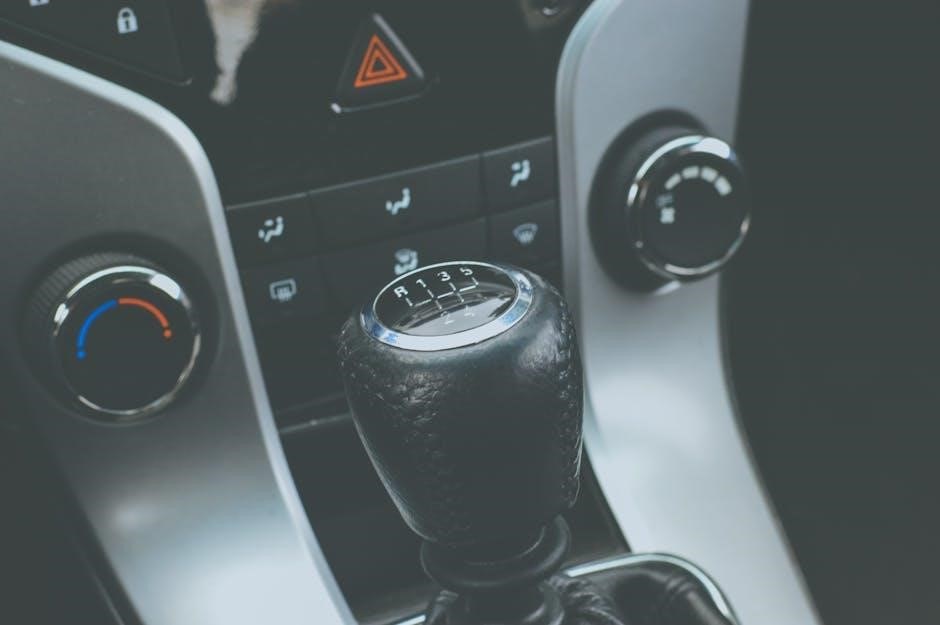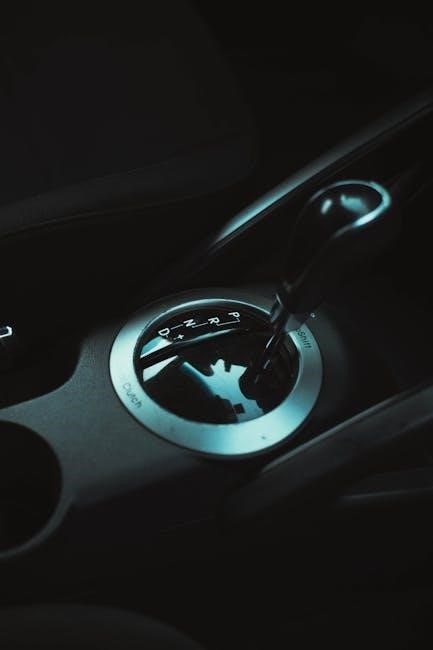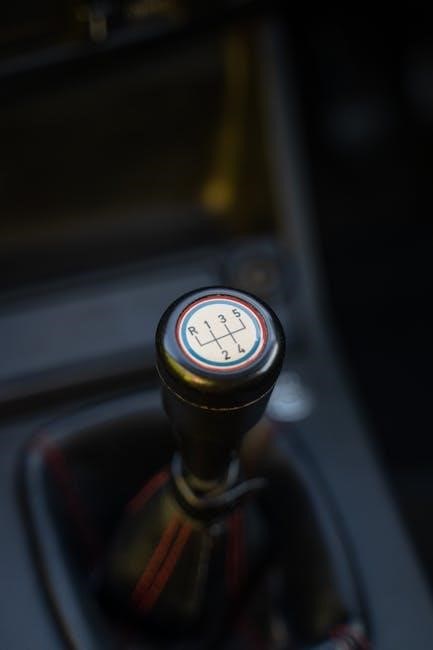4runner manual transmission
The Toyota 4Runner, a mid-size SUV, historically offered manual transmissions, but they were discontinued after the 2000 model year. The last manual 4Runner was in 2000.
1;1 Overview of the 4Runner and Its Transmission Options
The Toyota 4Runner, a mid-size SUV, has historically been known for its durability and off-road capabilities. Initially introduced in 1984, the 4Runner offered a range of transmission options to cater to different driver preferences. While automatic transmissions were always available, manual transmissions played a significant role in its lineup, particularly in earlier generations. The 4Runner’s manual transmission options, including a 5-speed unit paired with 4-cylinder and V6 engines, provided drivers with precise control and enhanced off-road performance. However, by 2000, Toyota phased out manual transmissions, leaving automatics as the sole option for subsequent models.
1.2 Historical Significance of Manual Transmissions in the 4Runner
Manual transmissions in the Toyota 4Runner hold a special place in its history, symbolizing its off-road heritage and driver engagement. Introduced in 1984, the manual transmission became a defining feature for enthusiasts, offering precise control and a connection to the vehicle’s rugged roots. Over the years, the 4Runner’s manual option complemented its 4-wheel-drive system, making it a favorite among off-road enthusiasts. However, declining demand and industry shifts led to its discontinuation after 2000, marking the end of an era for this iconic SUV, leaving behind a legacy cherished by those who valued the hands-on driving experience.

History of the 4Runner Manual Transmission
The 4Runner’s manual transmission debuted in 1984, offering a 5-speed option, and remained popular until its discontinuation after the 2000 model year due to declining demand.
2.1 First Generation (1984–1989): The Birth of the 4Runner
The first-generation Toyota 4Runner, introduced in 1984, was initially available with a 5-speed manual transmission paired with a 2.4L 22R I4 engine. This setup was standard across all models, including the basic passenger and utility versions. The manual transmission provided drivers with precise control, especially off-road, where the solid front axle and manual locking hubs enhanced capability. This generation laid the foundation for the 4Runner’s reputation as a rugged and reliable SUV, with the manual transmission being a key feature that appealed to off-road enthusiasts and those seeking a more engaging driving experience.
2.2 Second Generation (1990–1995): Expansion of Manual Transmission Options
The second-generation 4Runner, launched in 1990, expanded manual transmission options by offering both 4-cylinder and 6-cylinder engines paired with a 5-speed manual. This generation introduced a 4-door model, broadening appeal without compromising off-road prowess. The manual transmission remained a popular choice, especially for enthusiasts seeking control in challenging terrains. Although automatics became available, the manual transmission’s tactile driving experience kept it favored among off-road enthusiasts, ensuring its continued relevance in this era.
2.3 Third Generation (1996–2002): Peak of Manual Transmission Availability
The third-generation 4Runner, spanning 1996 to 2002, marked the peak of manual transmission availability. During this period, both 4-cylinder and 6-cylinder engines were paired with a 5-speed manual transmission, offering drivers enhanced control and performance. This generation saw improved off-road capabilities and refined on-road handling, making the manual transmission a favored choice among enthusiasts. The 5-speed manual remained a staple, providing a direct driving experience that resonated with off-road purists. However, this would also be the final generation to widely offer manual transmissions before their gradual decline.
2.4 Fourth Generation (2003–2009): The End of Manual Transmissions
The fourth generation of the 4Runner, produced from 2003 to 2009, witnessed the discontinuation of manual transmissions. This shift aligned with broader industry trends favoring automatics for convenience and smoother city driving. By 2003, the 5-speed manual was phased out entirely, replaced by a 5-speed automatic across all models. This decision reflected declining consumer demand for manual transmissions in SUVs, marking the end of an era for the 4Runner. The transition to automatic-only setups remained consistent throughout this generation, catering to a market increasingly prioritizing ease of use over driver engagement.

Decline of Manual Transmissions in the 4Runner
The 4Runner’s manual transmission declined as Toyota phased it out post-2000, reflecting industry trends and customer preference for automatics in SUVs.
3.1 Last Year of Manual Transmission: The 2000 Model
The 2000 model year marked the final availability of a manual transmission in the Toyota 4Runner. This phase-out aligned with broader industry shifts toward automatics, driven by customer demand for convenience and ease of use. The discontinuation of manual transmissions reflected Toyota’s strategic response to market preferences, as automatics became the preferred choice for SUV buyers. Since then, the 4Runner has exclusively featured automatic transmissions, ending an era that once offered drivers a more hands-on driving experience.
3.2 Shift to Automatic Transmissions: Industry Trends and Customer Demand
The shift from manual to automatic transmissions in the 4Runner aligns with broader automotive industry trends. Customer demand increasingly favored automatics for their convenience and ease of use, particularly in SUVs. As manual transmission sales declined across the market, Toyota responded by phasing out manual options to focus on automatics. This decision reflected evolving consumer preferences, as automatic transmissions became the preferred choice for their seamless performance and reduced driver effort, especially in urban and suburban driving environments.
3.3 The Role of the Tacoma Platform in Transmission Options
The Toyota 4Runner shares its platform with the Tacoma pickup truck, which still offers manual transmissions. However, the 4Runner shifted exclusively to automatics after 2000. While the Tacoma’s manual options suggest potential for the 4Runner, Toyota has not reintroduced manuals for the SUV. This divergence highlights Toyota’s strategic alignment with customer preferences, prioritizing automatics for the 4Runner to meet market demands for convenience and ease of use in SUVs.

Current State of the 4Runner Manual Transmission
Modern 4Runners no longer offer manual transmissions, as they were phased out after the 2000 model year. All current models exclusively feature automatic transmissions.
4.1 Absence of Manual Transmissions in Modern 4Runners
Modern Toyota 4Runners no longer offer manual transmissions, marking a significant shift in the vehicle’s design. The discontinuation began after the 2000 model year, with automatic transmissions becoming the sole option. This change aligns with broader industry trends, where automatics dominate due to customer preferences for convenience and ease of use. Toyota’s decision reflects reduced demand for manual transmissions in the SUV segment, prioritizing seamless driving experiences in both urban and off-road environments. As a result, the 4Runner now exclusively features automatic transmissions across all trim levels and model years beyond 2000.
4.2 Toyota’s Stance on Manual Transmissions for the 4Runner
Toyota has officially confirmed that manual transmissions will no longer be offered in the 4Runner. This decision aligns with industry trends favoring automatics for convenience and ease of use. The last manual transmission 4Runner was available in the 2000 model year, after which Toyota shifted exclusively to automatic transmissions. Despite enthusiast demand, Toyota has not reintroduced manual options, citing low customer demand. The 2025 Toyota 4Runner will continue this trend, featuring only automatic transmissions across all trim levels, reflecting Toyota’s strategic focus on meeting broader market preferences.
4.3 The 2025 Toyota 4Runner: Automatic Only
The 2025 Toyota 4Runner continues the trend of offering only automatic transmissions, with no plans to reintroduce manual options. Toyota has emphasized that customer demand for manual transmissions in the 4Runner is insufficient to justify their inclusion. The 2025 model features a refined automatic transmission system, designed to enhance both on-road performance and off-road capabilities. This decision reflects Toyota’s broader strategy to focus on automatic transmissions, aligning with industry trends toward convenience and ease of use in SUVs. Enthusiasts hoping for a manual revival will need to look to older models or other Toyota vehicles like the Tacoma.

Technical Specifications of 4Runner Manual Transmissions
The 4Runner’s manual transmissions were primarily 5-speed, paired with 4-cylinder or V6 engines, offering precise control for both on-road and off-road driving scenarios.
5.1 Engines Paired with Manual Transmissions
The 4Runner’s manual transmissions were paired with both 4-cylinder and V6 engines. The 22R 2.4L inline-four and 3.0L V6 were common pairings, offering reliable power and torque. These engines provided a balance of efficiency and capability, making them suitable for both on-road and off-road use. The manual gearbox enhanced driver control, especially in rugged terrain. The 5-speed manual was standard in early models, with the V6 option available until 2000. This combination catered to enthusiasts seeking a more engaging driving experience in a versatile SUV.
5.2 Transmission Types: 5-Speed Manual
The 4Runner featured a 5-speed manual transmission as its primary manual option. This gearbox was paired with both 4-cylinder and V6 engines, offering precise gear control and driver engagement. The 5-speed manual was known for its smooth shifting and durability, making it a favorite for off-road enthusiasts. It allowed drivers to maximize engine power and torque, especially in low-traction situations. The 5-speed manual remained a staple until its discontinuation in 2001, marking the end of an era for manual transmissions in the 4Runner lineup.
5.3 Four-Wheel-Drive Systems and Manual Transmissions
The 4Runner’s manual transmission was seamlessly integrated with its four-wheel-drive system, enhancing off-road capability. Drivers could manually lock hubs and engage 4WD, leveraging the clutch for low-speed control. This combination provided unmatched traction and precision in challenging terrains, making the manual 4Runner a favorite among off-road enthusiasts. The solid front axle in early models further complemented this setup, ensuring durability and reliability in rugged conditions. However, with the discontinuation of manual transmissions in 2001, this unique capability was lost, transitioning the 4Runner to automatic-only 4WD systems.

Performance and Capabilities
The manual transmission in the 4Runner enhanced off-road control and fuel efficiency, making it a preferred choice for adventurous drivers seeking precision and rugged performance.
6.1 Off-Road Performance with Manual Transmissions
Manual transmissions in the 4Runner excel in off-road scenarios, offering precise control over gear shifts. This allows drivers to maintain optimal torque and traction on challenging terrains. The ability to manually select lower gears enhances crawling capabilities and stability on steep inclines. Historical models, such as the first-generation 4Runners with solid front axles, were particularly adept at conquering rough trails. The tactile connection of a manual gearbox provided enthusiasts with a more immersive driving experience, making it a favorite among off-road enthusiasts until its discontinuation in 2000.
6.2 On-Road Driving Experience with Manual Transmissions
Manual transmissions in the 4Runner delivered a engaging on-road experience, offering precise control and responsiveness. Drivers could optimize gear shifts for smooth acceleration, especially in city driving. The tactile feedback of the clutch and shifter provided a more direct connection to the vehicle. While not as refined as automatics, manuals offered better fuel efficiency and reduced gear hunting. However, the 5-speed manual was discontinued for the V6 engine in 2001, marking the end of this option. Despite this, enthusiasts appreciated the manual’s ability to enhance driving dynamics on paved roads, making it a memorable feature of older 4Runner models.
6.3 Comparison of Manual vs. Automatic Transmissions
Manual and automatic transmissions in the 4Runner cater to different driving preferences. Manuals offered better fuel economy, lower costs, and precise control, appealing to enthusiasts. However, they required driver engagement. Automatics provided convenience and smoother city driving, especially with heavy loads or towing. The 5-speed manual was phased out for V6 models in 2001, and the 4-speed automatic became standard. By 2003, only automatics were available, reflecting market trends. While manuals delivered a more connected driving experience, automatics offered practicality, leading to their dominance in later 4Runner models.

Maintenance and Repair
Regular maintenance is crucial for manual transmissions. Check clutch wear, transmission fluid levels, and gear engagement. Addressing issues early prevents costly repairs and ensures smooth operation.
7.1 Common Issues with Older Manual Transmissions
Older 4Runner manual transmissions often face issues like worn-out clutches, gear grinding, and fluid leaks. The 5-speed manual, common in earlier models, may develop synchro wear, especially in higher mileage vehicles. Additionally, the clutch master and slave cylinders can fail over time, leading to a spongy pedal feel. Regular fluid changes and inspections can help mitigate these problems, but replacements may be necessary for parts showing significant wear. These issues are more prevalent in models from the 1990s and early 2000s, particularly those with heavy use or inadequate maintenance.
7.2 Tips for Maintaining a Manual Transmission 4Runner
Regular maintenance is crucial for extending the life of a manual transmission 4Runner. Start with routine clutch inspections to ensure proper engagement and avoid premature wear. Change the transmission fluid as recommended in the owner’s manual to keep gears lubricated and functioning smoothly. Additionally, listen for unusual noises during shifting, as they can indicate potential issues. Clean or replace the air filter regularly to maintain optimal engine performance, which directly affects transmission operation. Avoid aggressive driving habits, such as rapid acceleration or harsh clutch engagement, to reduce stress on the system. Finally, inspect the transmission mounts and linkage for wear or damage to ensure precise gear shifts.
7.3 Cost of Replacing a Manual Transmission
Replacing a manual transmission in a Toyota 4Runner can range from $1,500 to $4,000, depending on labor costs and parts. OEM parts are typically more expensive than aftermarket alternatives. Labor costs often make up the majority of the expense, averaging $500 to $1,500, while parts may cost $1,000 to $2,500. Additional repairs, such as replacing the clutch or flywheel, can increase the total cost. Model year and mileage also influence the price, with older or high-mileage vehicles potentially requiring more extensive work. Budgeting for extra fees and potential diagnostics is advisable for an accurate estimate.

Future Prospects
Toyota has no plans to reintroduce manual transmissions for the 4Runner due to low demand. The 2025 model remains automatic-only, aligning with industry trends favoring convenience.
8.1 Possibility of Manual Transmission Return
Despite enthusiast demand, Toyota has not indicated plans to reintroduce manual transmissions for the 4Runner. The 2025 model remains automatic-only, reflecting industry trends toward convenience. While the Tacoma still offers a manual option, the 4Runner’s platform shift and customer preferences favor automatics. Toyota’s focus on modernizing the 4Runner aligns with market demands, making a manual transmission return unlikely unless significant consumer interest resurges. For now, the 4Runner continues as an automatic-only SUV, catering to its primary buyer base seeking ease and practicality over manual driving experiences.
8.2 Impact of the Tacoma’s Manual Transmission on the 4Runner
The Tacoma’s availability with a manual transmission has sparked hopes among enthusiasts for the 4Runner. However, Toyota maintains the 4Runner’s focus on automatics, citing differing market demands. While the Tacoma targets off-road enthusiasts who value manual control, the 4Runner is positioned as a family-oriented SUV, prioritizing ease of use. This divergence suggests that the Tacoma’s manual option doesn’t directly influence the 4Runner’s transmission choices. Thus, the 4Runner remains committed to automatic transmissions, aligning with its target demographic’s preferences for comfort and convenience.
8.3 Toyota’s Strategy for Manual Transmissions in SUVs
Toyota has shifted focus toward automatic transmissions for the 4Runner, reflecting broader industry trends favoring convenience and ease of use. While the Tacoma retains manual options for off-road enthusiasts, the 4Runner targets a different demographic, prioritizing practicality. Toyota’s strategy aligns with declining manual transmission demand, emphasizing automatics for smoother, more accessible driving experiences. This approach underscores the company’s commitment to meeting customer preferences, even as manual transmissions fade from its SUV lineup, including the 4Runner.

Buyer’s Guide
Buyers seeking a manual 4Runner should focus on 1996–2000 models, as these were the final years offering manual transmissions. Ensure the vehicle has 4WD capability for optimal performance.
9.1 Which Model Years to Look For
Buyers interested in a manual transmission 4Runner should focus on models from 1996 to 2000. These years represent the final era when manual transmissions were available. The 1996–2002 third generation is particularly sought after, as it offers both 4-cylinder and V6 engine options with manual transmissions. The 2000 model year is the last to feature a manual transmission, making it a key target for enthusiasts. Ensure the vehicle is equipped with 4WD for optimal performance and value. These models provide the best balance of reliability and off-road capability for manual transmission fans;
9.2 Key Features to Check in a Manual Transmission 4Runner
When searching for a manual transmission 4Runner, focus on models with the 5-speed manual gearbox, available from 1984 to 2000. Ensure the vehicle has a solid front axle for optimal off-road performance; Check for a 4WD system with manual locking hubs, as this enhances capability. Verify the engine type, as both 4-cylinder and V6 engines were paired with manual transmissions. Inspect the clutch and gearbox for wear, and ensure all gears engage smoothly. Additionally, look for models with minimal modifications to maintain authenticity and reliability. A well-maintained manual 4Runner offers both durability and driving satisfaction.
9.3 Avoiding Common Mistakes When Purchasing
When buying a manual transmission 4Runner, avoid assuming all models have a manual option, as post-2000 models are automatic only. Do not overlook the condition of the transmission and clutch, as wear can lead to costly repairs. Be cautious of modified vehicles, as they may have altered drivetrain components. Ensure the 4WD system functions properly, especially the manual locking hubs. Verify the vehicle’s history to avoid models with high mileage or signs of neglect. Lastly, test drive the vehicle to ensure smooth gear engagement and clutch operation. A thorough inspection is essential to avoid future issues.

Legacy and Cultural Impact
The 4Runner’s manual transmission era left a lasting legacy, cherished by enthusiasts for its off-road prowess and driving engagement, symbolizing a bygone era of automotive simplicity.
10.1 The Role of Manual Transmissions in the 4Runner’s Reputation
The manual transmission played a significant role in shaping the 4Runner’s reputation as a rugged, off-road-capable SUV. Its availability until 2000 appealed to enthusiasts who valued driving engagement and precision control. The manual gearbox became synonymous with the 4Runner’s identity, enhancing its status among adventure seekers. While its discontinuation marked a shift toward modern convenience, the legacy of the manual transmission remains a cherished part of the 4Runner’s history, symbolizing a connection to its roots and off-road heritage.
10.2 Enthusiast Community and Demand for Manual Transmissions
A dedicated enthusiast community continues to advocate for the return of manual transmissions in the 4Runner. Many off-road enthusiasts and driving purists prefer the control and connection that a manual gearbox provides. Despite Toyota’s shift to automatics, forums and social media groups frequently express nostalgia and desire for a manual option. This demand highlights the emotional and functional connection enthusiasts have with manual transmissions, keeping the legacy alive even as the automotive industry moves toward automation.
10.3 The End of an Era: Reflecting on the Manual 4Runner
The discontinuation of manual transmissions in the 4Runner marks the end of an era for driving enthusiasts. Once a staple in early models, the manual gearbox offered a unique connection between driver and vehicle. Its absence has sparked nostalgia, as many recall the tactile experience of shifting gears. While the Tacoma still offers manual options, the 4Runner’s shift to automatics reflects broader industry trends. For purists, the loss of the manual 4Runner symbolizes the fading of a driving tradition, leaving behind a legacy cherished by those who value hands-on control and the joy of manual driving.
The 4Runner’s manual transmission journey concluded in 2000, leaving enthusiasts nostalgic. Toyota’s shift to automatics aligns with industry trends, but a dedicated community still cherishes the legacy.
11.1 Summary of the 4Runner Manual Transmission Journey
The Toyota 4Runner’s manual transmission journey began in 1984 with its first generation and lasted until the 2000 model year. Over this period, the manual transmission evolved, offering both 4-cylinder and V6 engine options. However, declining demand and industry shifts toward automatics led to its discontinuation. Toyota officially phased out manual transmissions in 2001, marking the end of an era. Despite this, the legacy of the manual 4Runner remains cherished by enthusiasts, symbolizing a connection to its off-road roots. While Toyota currently shows no signs of reintroducing manual transmissions for the 4Runner, the dedicated community continues to celebrate its heritage.
11.2 Final Thoughts on the Future of Manual Transmissions
The future of manual transmissions in the Toyota 4Runner appears unlikely, as Toyota has prioritized automatics due to low demand. However, enthusiasts hold onto hope, inspired by the Tacoma’s manual option. While Toyota hasn’t hinted at reintroducing manuals for the 4Runner, niche demand could influence future decisions. For now, the 4Runner remains automatic-only, catering to modern preferences. Despite this, the legacy of the manual 4Runner endures, cherished by off-road enthusiasts and driving purists alike, symbolizing a connection to its rugged heritage.